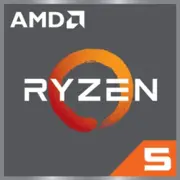AMD Ryzen 5 3400GE

AMD Ryzen 5 3400GE: Budget APU for Compact Systems (April 2025)
Updated review of a processor that remains relevant years after its release.
Key Specifications: Architecture and Performance
The AMD Ryzen 5 3400GE, released in 2019, still finds its niche thanks to its balance of price and capabilities. Built on the Zen+ architecture (codename Picasso) and 12nm process technology, it features 4 cores and 8 threads with a base clock of 3.3 GHz and a boost clock of up to 4 GHz. With integrated Radeon Vega 11 graphics (704 stream processors), it is classified as an APU—a hybrid of CPU and GPU.
Key Features:
- Low TDP of 65W — suitable for compact systems.
- Support for Precision Boost 2 technology for automatic overclocking.
- 4MB of L3 cache, which seems modest by 2025 standards but is sufficient for basic tasks.
Performance:
- In the Geekbench 6 test (2025), the 3400GE scores 1009 points in single-threaded and 3013 in multi-threaded modes. This is adequate for office applications, browsing, and light gaming (e.g., Dota 2 on medium settings at 1080p).
Compatible Motherboards: Sockets and Chipsets
The processor uses the AM4 socket, which AMD supported until 2023. Suitable motherboards include:
- A320/B450 — budget options, but may require a BIOS update.
- B550/X570 — support PCIe 4.0, but the APU operates only with PCIe 3.0.
Examples of motherboards (2025):
- ASRock B450M-HDV R4.0 ($65): a compact mATX, suitable for office PCs.
- Gigabyte B550M DS3H ($110): a better option for upgrading to newer processors.
Important: When choosing, check for HDMI/DisplayPort availability for connecting a monitor through the integrated graphics.
Memory Support: DDR4 as the Standard
The Ryzen 5 3400GE works only with DDR4 memory (up to 2933 MHz in dual-channel mode). In 2025, DDR5 dominates the market, but it is not relevant for this processor.
Recommendations:
- Optimal amount: 16GB (2x8GB) with a frequency of 3200 MHz (will automatically downclock to 2933 MHz).
- Popular models: Corsair Vengeance LPX 16GB (3200 MHz) — $45.
Power Supply: Calculations and Examples
With a TDP of 65W, the processor does not require a powerful PSU. However, adding a discrete graphics card (e.g., Radeon RX 6400) increases the minimum power requirement.
Tips:
- For a system without discrete graphics, a 300–400W PSU is sufficient (e.g., EVGA 400 N1, $35).
- With a mid-range GPU (NVIDIA GTX 1650) — 450–500W (Corsair CX450M, $55).
Important: Don’t skimp on certifications (80+ Bronze or higher) — this ensures stability.
Pros and Cons of Ryzen 5 3400GE
Strengths:
- Energy efficiency: ideal for mini-PCs and HTPCs.
- Integrated graphics: replaces budget graphics cards.
- Price: new processor costs around $120 (2025), which is cheaper than the Ryzen 5 5600G ($170).
Weaknesses:
- 4 cores: multi-threaded tasks (rendering, streaming) are challenging.
- Outdated process technology: 12nm versus 7nm for the Ryzen 5000 series.
- No support for PCIe 4.0.
Use Cases: Where is the 3400GE Relevant in 2025?
1. Office PCs and Home Systems:
- Working with documents, browsers, Zoom.
- Example: build based on ASRock A320M-HDV ($60) + 16GB DDR4 — a total of $250.
2. Media Centers (HTPCs):
- 4K video via HDMI 2.0, streaming Netflix.
3. Light Gaming:
- CS:GO, Fortnite, Genshin Impact on low/medium settings (40–60 FPS).
4. Educational Projects:
- Programming, virtual machines (for basic tasks).
Comparison with Competitors
- Intel Core i3-13100F ($110):
4 cores/8 threads, higher IPC, but requires a discrete GPU. Suitable for gaming with a discrete GPU.
- AMD Ryzen 5 5600G ($170):
6 cores/12 threads, Vega 7 graphics is weaker, but the CPU is more powerful. A choice for those needing more performance.
- Intel N100 (NVIDIA) — integrated into mini-PCs ($150–200):
More power-efficient, but has 4 cores without Hyper-Threading. Falls short in multitasking.
Conclusion: The 3400GE wins only when on a tight budget and in need of integrated graphics.
Practical Assembly Tips
1. Case: Choose compact models with good ventilation (e.g., Cooler Master MasterBox Q300L).
2. Cooling: The stock cooler is sufficient, but for quiet operation consider Arctic Freezer 34 ($30).
3. BIOS: For A320/B450 boards, update the firmware to a version supporting Zen+.
4. Upgrade: Don’t plan to install top-tier GPUs — the processor will become a bottleneck.
Final Conclusion: Who is the Ryzen 5 3400GE For?
This processor is an option for those who:
- Are building a budget PC under $400.
- Need a quiet and compact system (office, media center).
- Do not plan to run AAA games or heavy editing software.
Alternative: If the budget allows, it’s better to opt for the Ryzen 5 5600G or Intel i3-13100 + graphics card. But for “minimal hardware — maximum functionality” tasks, the 3400GE remains a valuable choice even in 2025.
Prices are current as of April 2025. When building, consider regional differences and availability of components.
Basic
CPU Specifications
Memory Specifications
GPU Specifications
Miscellaneous
Benchmarks
Compared to Other CPU
Share in social media
Or Link To Us
<a href="https://cputronic.com/en/cpu/amd-ryzen-5-3400ge" target="_blank">AMD Ryzen 5 3400GE</a>